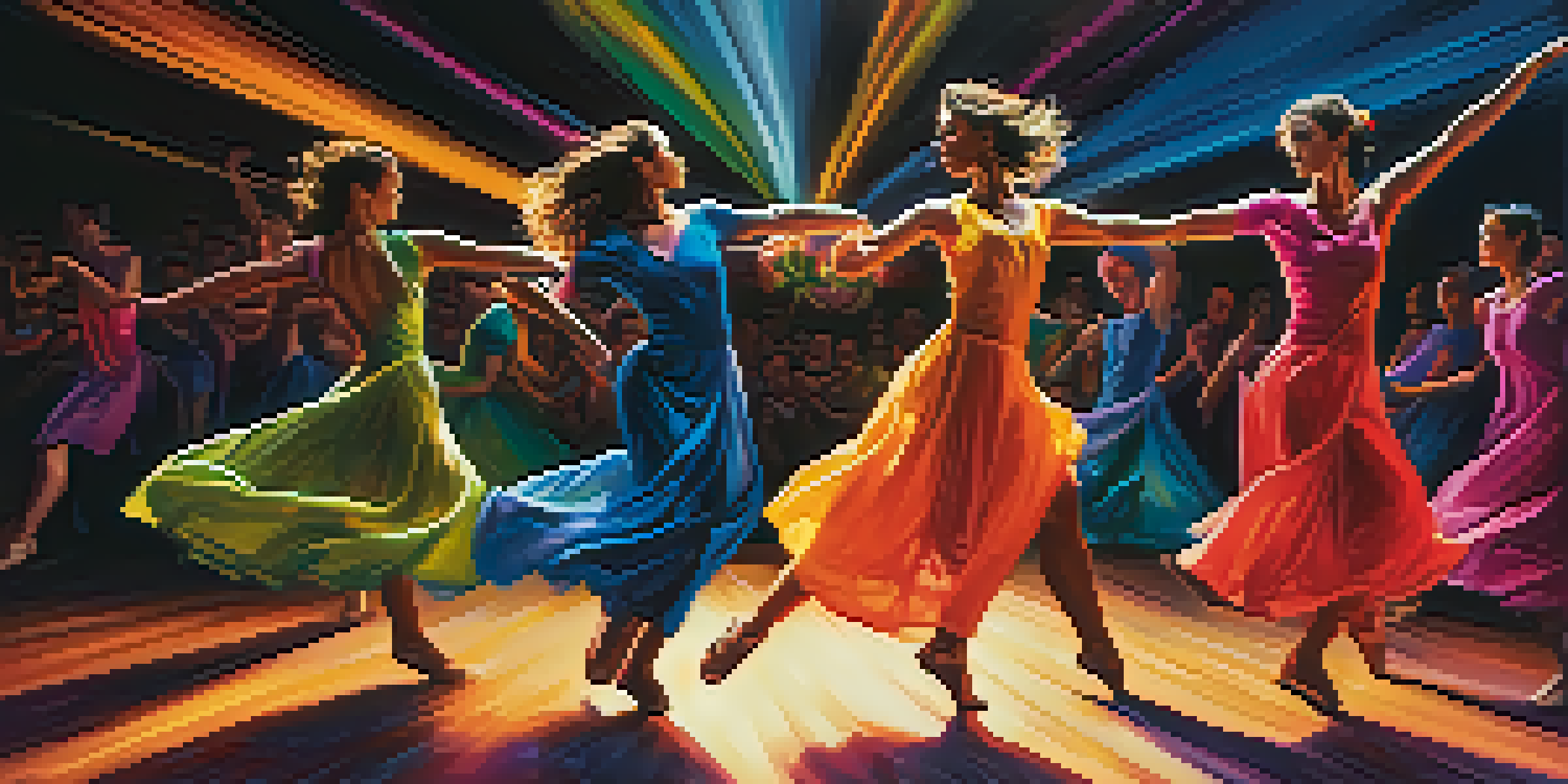The Role of Language in Dance Criticism and Appreciation

Understanding the Importance of Language in Dance
Language is the bridge that connects audiences to dance. It allows critics and enthusiasts alike to articulate their experiences and interpretations of movement. Just as a painter uses colors to express a vision, dance critics use language to convey the emotions and nuances behind a performance.
Dance is the hidden language of the soul.
When we talk about dance, we’re not just describing physical movements; we’re capturing feelings, stories, and cultural contexts. This interplay between language and dance enhances our understanding and appreciation of the art form. Without precise language, the rich tapestry of dance can easily become lost or misinterpreted.
Moreover, the language surrounding dance can influence how it is perceived in broader cultural conversations. Whether it’s through academic discourse or casual reviews, the words we choose shape the narrative around dance and its significance in society.
The Role of Dance Criticism in Shaping Public Perception
Dance criticism plays a pivotal role in how performances are received by the public. Critics have the power to elevate a dancer’s work, influencing audience perceptions and even ticket sales. A well-crafted review can ignite interest and curiosity, while a poorly articulated critique might deter potential viewers.

Moreover, the language used in criticism can reflect and challenge societal norms. Critics often provide insights that prompt audiences to think critically about the themes presented in a dance performance, such as identity, politics, and cultural heritage. This dialogue fosters a deeper engagement with the art form.
Language Connects Dance and Audience
Language serves as a vital link between dance performances and their audience, enhancing understanding and appreciation of the art form.
Ultimately, the language of criticism serves not just to evaluate, but to educate. Through thoughtful analysis, critics can help audiences appreciate the complexities of dance, encouraging them to explore beyond the surface and find personal connections to the performances.
Descriptive Language: Bringing Dance to Life
Descriptive language is essential in dance criticism; it paints a vivid picture of the performance for those who may not have witnessed it live. Words can evoke the energy, grace, and emotion conveyed through movement, helping readers visualize the dance. For example, describing a dancer's fluidity can transport the audience to the moment, allowing them to feel the performance.
The only way to make sense out of change is to plunge into it, move with it, and join the dance.
Metaphors and similes often enhance this descriptive power. When a critic likens a dancer’s movements to flowing water or a bird in flight, it creates an immediate emotional connection. This not only enhances understanding but also makes the experience more relatable, as readers can draw upon their own experiences with these familiar images.
Furthermore, effective descriptions can also highlight the technical aspects of dance, such as choreography, timing, and expression. By balancing technical language with evocative imagery, critics can appeal to both seasoned dance aficionados and newcomers alike, creating a shared appreciation for the art.
The Influence of Cultural Context on Dance Language
Cultural context plays a critical role in shaping the language used in dance criticism. Different cultures have unique expressive styles, and the terminology used to describe these can vary significantly. Understanding the cultural nuances behind a dance performance enriches both critique and appreciation, allowing for a more authentic engagement.
For instance, terms rooted in specific dance traditions carry a weight of historical and cultural significance. A critic familiar with these traditions can better articulate the dancer's intent and the performance's overall impact. This depth of understanding fosters a richer dialogue between the art form and its audience.
Criticism Shapes Public Perception
Dance criticism has the power to influence audience perceptions and engagement, shaping the narrative around performances and their cultural significance.
Moreover, as the global dance landscape evolves, critics are challenged to adapt their language to reflect these changes. The emergence of fusion styles and cross-cultural influences necessitates a more inclusive vocabulary that resonates with diverse audiences, ultimately enriching the dialogue around dance.
Language Accessibility in Dance Criticism
Accessibility in language is crucial for widening the audience for dance criticism. When critics use overly complex jargon, they risk alienating readers who may not have a background in dance. Striking a balance between being informative and being approachable can invite more people into the conversation about dance.
Using clear and concise language allows critics to communicate ideas effectively, making dance more relatable. For example, breaking down technical terms or explaining concepts like 'pirouette' or 'plié' can enhance understanding for those unfamiliar with the dance world. This approach not only educates but also fosters a sense of community amongst dance enthusiasts.
Moreover, accessible language can encourage diverse voices to engage in dance criticism. By inviting different perspectives, we enrich the critique landscape and inspire broader appreciation for the art form. Ultimately, the goal is to make dance criticism a space where everyone feels welcome to share their thoughts and insights.
The Power of Personal Narrative in Dance Writing
Personal narratives can add a unique dimension to dance criticism. When critics share their own experiences and feelings in relation to a performance, it creates a personal connection with the audience. This storytelling aspect helps readers relate their own experiences to the dance, making it more impactful and memorable.
For instance, a critic might recount how a particular performance resonated with their own journey, adding layers of meaning that go beyond technical analysis. This approach invites readers to see dance not just as a series of movements, but as a reflection of human experience and emotion.
Cultural Context Enriches Dance Language
The cultural context behind dance performances informs the language used in criticism, fostering a deeper engagement and understanding among audiences.
Additionally, personal narratives can highlight the transformative nature of dance. By sharing how a performance inspired or moved them, critics can convey the power of dance to evoke feelings and provoke thought. Such narratives not only enrich the criticism but also inspire others to explore and appreciate dance in their own lives.
Future Trends in Dance Criticism and Language Use
As the world of dance continues to evolve, so too will the language used in its criticism. The rise of digital platforms and social media has changed how we consume and engage with dance. Critics are now tasked with adapting their language to fit various formats, from concise tweets to in-depth blogs, while still conveying the essence of a performance.
Moreover, the increasing diversity in dance styles and practitioners calls for a more inclusive and varied vocabulary. Critics must be mindful of representing different cultural perspectives and artistic expressions, ensuring that their language reflects the richness of the dance community.

Looking ahead, the integration of technology in dance, such as virtual reality and digital performances, will also influence how we talk about dance. As these innovations reshape the landscape, critics will need to develop new ways of articulating the experience, blending traditional language with modern expressions to keep the dialogue vibrant and relevant.